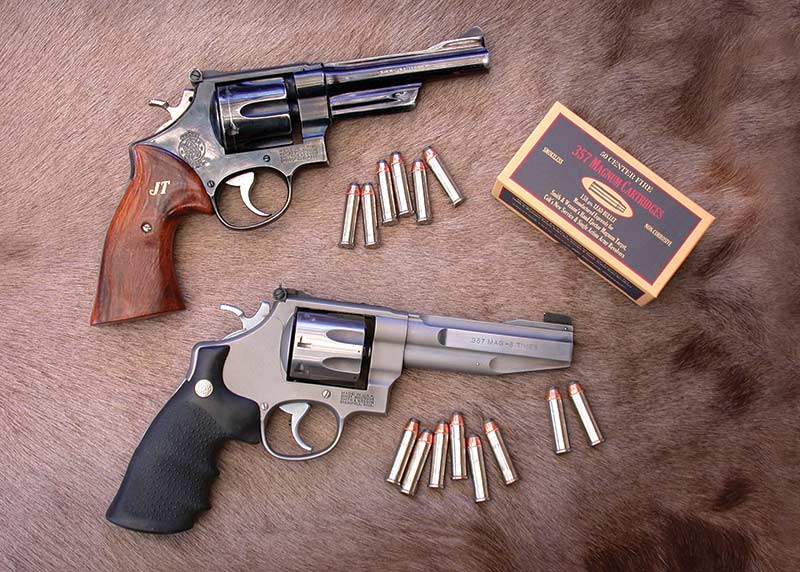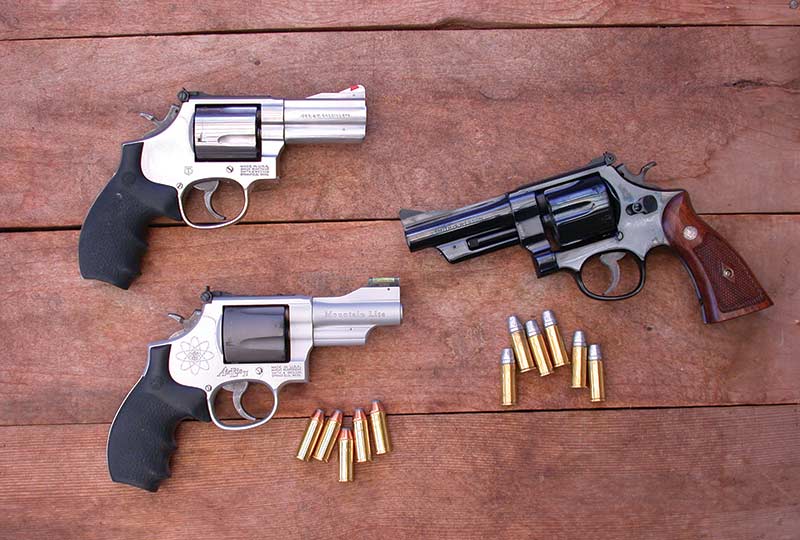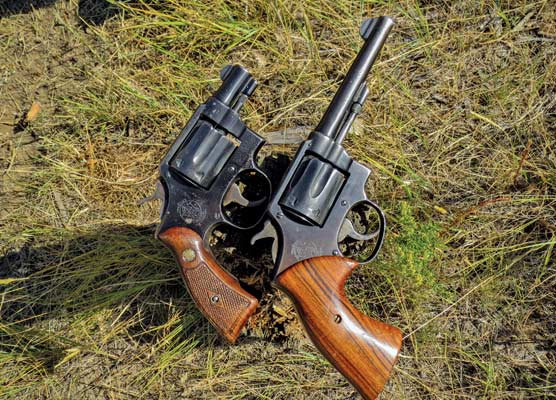Is Newer Better?
The 1950s were especially notable for sixguns. The decade began with the introduction of Smith & Wesson’s 1950 Target Model in .44 Special and .45 ACP and ended in 1959 with the advent of Ruger’s Super Blackhawk. During the early years of the decade the S&W .357 Magnum began to be available as only a relatively few were manufactured in the pre-War years. From 1953 to 1956 was an exceptionally active time for the introduction of new sixguns. Ruger began with the .22 Single-Six in 1953, followed by the .357 Blackhawk (1955), and the .44 Blackhawk (1956); Smith & Wesson’s offerings included the Highway Patrolman (1954), the Combat Magnum and the 1955 Target (1955) and the .44 Magnum in 1956.
Meanwhile over at Colt we saw the introduction of the Three-Fifty-Seven in 1954 followed by the .357 Python in 1955 and the resurrection of the Colt Single Action Army in 1956. In the midst of all this firearms production activity, a landmark book, Sixguns by Keith also arrived. It would have a great effect on younger shooters. At about the same time Elmer Keith was writing his book, a young Utah gunsmith by the name of Dick Casull was beginning the experiments leading to the present day .454 Casull.
More Change
In the 1960s S&W brought forth their first stainless steel revolver, the Model 60 .38 Special, which is nothing more than the Chief’s Special constructed of a new material. No one ever thought stainless steel would become the choice of firearms manufacturers way back then. Many said stainless steel would not be strong enough for the larger sixguns. Today all Freedom Arms revolvers are constructed of
stainless steel, most of the Smith and Wesson catalog consists of stainless steel revolvers, and although I don’t have any figures to back up my conjecture, I would guess most Ruger sixguns are also crafted of stainless steel.
The only thing that never changes is the fact everything changes. So where are all the sixguns mentioned as being manufactured in the 1950s? Every single Smith & Wesson is gone from the catalog. They have been replaced by new sixguns, albeit with some classics returning just now. But will the classic trend continue? The Colt Single Action Army is still here, with some internal changes as to hand, cylinder ratchet, base pin bushing and barrel threads.
Ruger’s Flat-Top Blackhawks action sixgun. The original Super Blackhawk .44 remains albeit in the New Model form and offered in both blue and stainless models. It has been further improved with the Bisley Model and the Hunter Model in both standard form and Bisley configuration. With the re-introduction of the Flat-Top recently, we’re at least seeing a return of a few of the classics.
In addition to the New Model single actions from Ruger, a new chapter has been written on double action sixguns with Ruger’s extremely strong lineup of DA revolvers. First came the Ruger Redhawk, which was then followed by the Super Redhawk now offered in .44 Magnum, .454 and .480 Ruger.
Most of the great guns of my youth are now gone, though. If I want to add to my collection of 1950s sixguns it’s necessary to search gun shows and auction sites as well as depending upon friends and readers to alert me to some special offering. became the Old Model Blackhawks in 1963 and then the in turn became the New Model Blackhawks in 1973 with the first transfer bar action that allowed safe carrying of six rounds in a single action sixgun. The original Super Blackhawk .44 remains albeit in the New Model form and offered in both blue and stainless models. It has been further improved with the Bisley Model and the Hunter Model in both standard form and Bisley configuration. With the re-introduction of the Flat-Top recently, we’re at least seeing a return of a few of the classics.
New Gun Goodness?
I don’t know if young shooters today are moved emotionally by the new guns being offered as I was nearly 50 years ago. For me the great guns of the 1950s continue to stir my soul, spirit, heart and mind. They are not just tools but works of art. For me they hold great aesthetic appeal. Have we progressed or regressed in the last 50 years? Is newer better? How about if it’s a new version of a classic?
Emotionally I would have to say the old guns were better. However, it is much preferred to normally operate on facts rather than emotion. So pushing emotion to the back burner, I’ll try to look at the facts. Those facts are yesterday’s guns were much more beautifully designed and finished, usually had better trigger pulls out of the box and more easily gave pride of ownership. They were naturals for engraving and carved ivory grips. Knowing full well beauty is in the eye of the beholder, I would still say most of these old sixguns could have an honored place in any art museum in the world.
On the other hand, newer guns are stronger, normally have tighter tolerances, and in every case I have tested them head to head with comparable older guns they have proven to be more accurate. We expect the offerings of Freedom Arms to be exceptionally accurate. However my stainless steel S&W Model 629 MagnaClassic and Ruger Hunter Model .44s also shoot decidedly better groups than my 1950s Model 29 or Super Blackhawk.
In addition to being more accurate, many of today’s sixguns are made of stainless steel, which is certainly a better material for the active outdoorsman. Add to this the fact we now have not only the .44 Magnum, we also have the .454 Casull, the .480 Ruger the .475 Linebaugh and even the .500 Magnum, all available in factory chamberings.
Finally firearms are much cheaper relatively speaking than they were in the 1950s. Wages have gone up much faster than firearms prices and we have to work a lot less hours to afford a quality firearm today.
I’ll continue to look for sixguns of the 1950s and buy them anytime I find them at a good price, or at least a price I can afford. They will go right into the safe alongside modern sixguns from Freedom Arms, Ruger and Smith & Wesson.
Subscribe To American Handgunner

Get More Revolver Content Every Week!
Sign up for the Wheelgun Wednesday newsletter here:








